Alcohol & Drug Detox Centers – Guide To Withdrawal From Substance Abuse
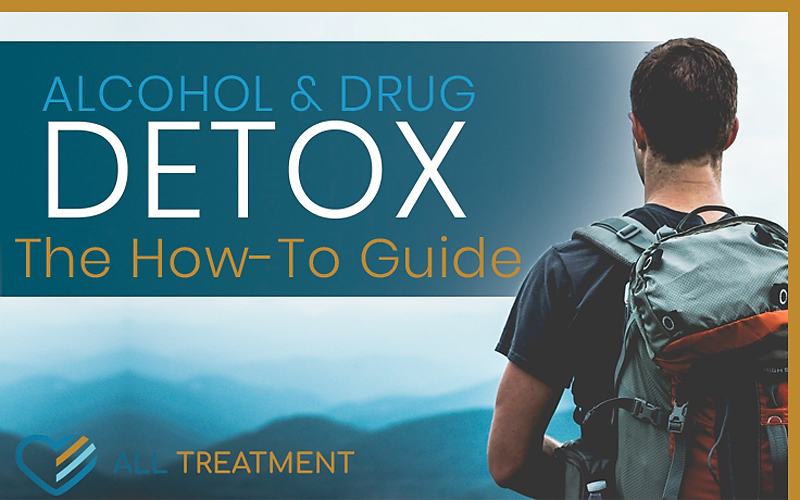
Learn About Detoxification From Drug and Alcohol Addiction
List Of All Alcohol And Drug Detox Centers Nearby
Detox Facilities for Alcohol and Drug Abuse
Navigation:
- Drug Detoxification
- Alcohol Detox
- Opioid Detox
- Cocaine and Crack Cocaine Detox
- Hallucinogen Detox
- Benzodiazepine Detox
- Club Drug Detox
- ADHD Medication Detox
- Sleeping Pills Detox
- Crystal Meth Detox
- Bath Salt Detox
- Kratom Detox
- Polysubstance Detox
- Detox is Not Drug Treatment
Drug Detoxification
Drug dependence and addiction remain pervasive throughout the United States, and as various forms of treatment continue to grow in numbers, so do individualized approaches, in an effort to help people overcome their addictions.
One of the main factors in continued drug abuse and addiction is a fear of withdrawal symptoms, which can range from mild to extremely severe and life threatening, depending on the substance, other factors surrounding individual health, and the severity of the addiction.
Although there are a few drugs most commonly associated with detoxification, addiction to any drugs can cause varying withdrawal symptoms, and each class of drugs calls for certain detox protocol to safely remove the toxins from a person’s system.
These drugs include:
- Opioids, such as morphine, heroin, fentanyl, and other opioid painkillers
- Cocaine and crack cocaine
- Hallucinogens such as PCP
- Alcohol
- Benzodiazepines, such as alprazolam (Xanax®), clonazepam (Klonopin®), and diazepam (Valium®)
- Club drugs, such as GHB, ketamine, and ecstasy
- ADHD medications, such as Adderall®, Vyvanse®, and Ritalin®
- Sleeping pills, such as Ambien®, Lunesta®, and Sonata®
- Crystal meth
- Bath salts (synthetic cathinones)
- Kratom
- Polysubstance (three or more drugs)
For anyone addicted to one or more substances, detox is the first step along the pathway to recovery. The first step of detox can be a significant hurdle for many addicted individuals, as the withdrawal symptoms resulting from addiction can be extremely discouraging. It’s not just the difficulty of withdrawal but the specific symptom of cravings that can prove to be an even greater obstacle once detox is completed. Withdrawal symptoms can be painful and cause a whole host of health complications. Additionally, cravings can be extremely intense and linger for several weeks or months thereafter. The ability of a person suffering from addiction to overcome both detox and cravings without medical and professional assistance is unrealistic. Therefore, drug rehab should always immediately follow a medically supervised detox procedure.
Opioid Detox
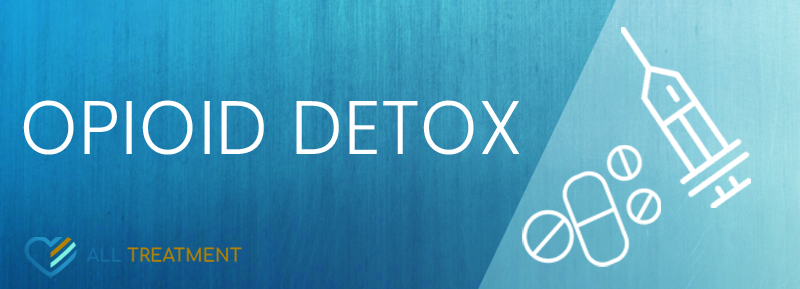 Opioid addiction is a serious epidemic in the United States today, but it is not new. Unfortunately, it has only worsened, affecting individuals, families, and communities throughout the nation, mainly due to the explosion of addictive opioid painkillers flooding the pharmaceutical markets.
Opioid addiction is a serious epidemic in the United States today, but it is not new. Unfortunately, it has only worsened, affecting individuals, families, and communities throughout the nation, mainly due to the explosion of addictive opioid painkillers flooding the pharmaceutical markets.
Opioid Withdrawal Symptoms
Virtually all opioids act the same way to affect a user, providing a euphoric rush followed by calming and sedative effects. Opioids create physical and psychological dependence, and with growing tolerance, the onset of withdrawal symptoms comes in a shorter period of time.
The symptoms of withdrawal associated with opioids include:
- Flu-like symptoms: high fever, nausea, vomiting, muscle aches, runny nose, and severe headache
- Kicking or twitching of arms and legs
- Severe cravings
- Anxiety
- Abdominal pains
- Diarrhea
- Sweating
- Severe agitation
- Insomnia
- Cold sweats
- Watery eyes
- Excessive yawning
While the symptoms of opioid withdrawal are not typically life-threatening, they can be extremely severe and certainly painful and uncomfortable enough that those suffering from addiction will do anything for relief. This is why most attempts to stop the use of opioids without medical assistance, often in a controlled environment, do not work.
Opioid Detox Options
Over the past twenty years, several options have become available for opioid detox, adding to what were limited choices of either a medically supervised detox or foregoing detox and opting for methadone maintenance. While medically supervised detox is still the most popular and commonly used procedure, there has been a significant advancement in to help people withdraw from problem opioids and begin a drug rehabilitation with less discomfort. One of the most common options is clonidine, used for the symptoms of anxiety, agitation, sweating, runny nose and cramping. Also, recently announced by the FDA, a new non-opioid medication has been approved to reduce the physical symptoms of opioid withdrawal. As of May 16, 2018, lofexidine hydrochloride (brand name Lucemyra®) is scheduled to come to market over the summer of 2018, and is the latest drug added to the growing arsenal in the battle against the opioid addiction scourge.1 Similar to clonidine, this new medication reduces the discomfort associated with opioid withdrawal. It is important to note that neither clonidine nor lofexidine hydrochloride will ease the intense cravings inherent in withdrawal. With cravings being the most common reason for relapse among opioid addicts, drug treatment is recommended after detox has been completed.
Medically Supervised Opioid Detox
The most common form of opioid detox is a medically supervised process, which usually takes place in a medical setting. With the exception of serious pre-existing medical conditions, opioid detox is not life-threatening. That said, opioid detox should always be medically supervised because complications may arise depending on the individual’s health, exclusive of previously diagnosed medical conditions. Further, the discomfort, pain, and potential for complications can be modulated with medications provided by medical staff.
Opioid Addiction Medication-Assisted Treatment
Growing in approval and popularity, medication-assisted treatment for opioid detox is one of the quickest ways to stop opioid abuse, as it completely eliminates the need to go through withdrawal symptoms and a painful detox process.
Two medications—methadone and buprenorphine—are used for this process. Both are synthetic opioids, which bind to the opioid receptors, thus preventing withdrawal symptoms and cravings. Both of these drugs are effective for opioid detox in that they are very long acting, lasting twenty-four to seventy-two hours. The long action of these medications allows them to be administered daily, without concern for withdrawal symptoms. Both medications are highly regulated and must be used only in conjunction with a drug treatment program, whether inpatient or outpatient. Only specifically certified medical professionals are authorized to prescribe these opioids, but the treatment is widely available in private medical practices and through authorized drug treatment programs.
The difference between methadone and buprenorphine exists in the fact that methadone is a full opioid agonist, which means its composition is no different from that of other opioids, and it can be abused, leading to serious injury and even death. Although methadone has been engineered to be a full opioid agonist, it does not provide the euphoria of other opioids. Its long action of twenty-four to thirty-six hours allows for the prevention of withdrawal symptoms, and its tight regulation discourages abuse. Methadone is typically given under supervision, as a liquid, making it impossible for addicts to “cheek” the medication and save it for later abuse.
Similar to methadone, buprenorphine is effective due to its long action, which can be twenty-four to seventy-two hours, depending on dosage. The biggest difference between buprenorphine and methadone is that buprenorphine is a partial opioid agonist and includes the drug naloxone. Naloxone is an opioid antagonist and is sometimes used in life-saving efforts to reverse the effects of an opioid overdose. Naloxone is completely inactive in this combination drug unless it is abused by someone attempting to inject the medication. Upon injection, naloxone becomes fully active and precipitates acute opioid withdrawal. Another safeguard of buprenorphine is the fact that it has a ceiling in the euphoric opioid effects it produces, and once it reaches a plateau, no further dosages can increase its euphoric effects.
In response to a frequent concern of how this form of replacement therapy helps opioid-addicted individuals to achieve sobriety, the medications can be tapered down in dosage at such time that the individual and their authorized physician agree that it is safe to do so. The time at which it is typically considered safe to taper down the dosage of methadone or buprenorphine will be dependent on the person being treated and how well acclimated he or she has become with living a healthy and productive life, free of drug abuse.
Cocaine and Crack Cocaine Detox
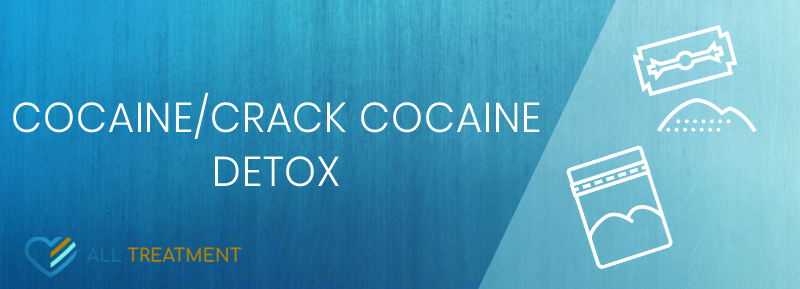 Cocaine, a powder—known as “crack” in its freebase form—is a powerful and addictive stimulant. Mainly affecting psychological functions, cocaine is a drug most commonly abused in binges, where one period of use can last for several hours or days at a time. Since cocaine and crack have very short lengths of action, a person experiences a fast and intense rush of euphoria followed by a severe “come down,” or “crash.” More of the drug is immediately necessary in order to prevent withdrawal symptoms, which can be moderate to severe, depending on the individual and the severity of addiction.
Cocaine, a powder—known as “crack” in its freebase form—is a powerful and addictive stimulant. Mainly affecting psychological functions, cocaine is a drug most commonly abused in binges, where one period of use can last for several hours or days at a time. Since cocaine and crack have very short lengths of action, a person experiences a fast and intense rush of euphoria followed by a severe “come down,” or “crash.” More of the drug is immediately necessary in order to prevent withdrawal symptoms, which can be moderate to severe, depending on the individual and the severity of addiction.
Withdrawal from cocaine and crack, like other abused drugs, comes with intense cravings to ease the discomfort of the symptoms. Because cocaine’s effects are mainly psychological, the withdrawal symptoms can have extremely adverse effects on an individual’s mental state.
Some of the most common symptoms of cocaine and crack withdrawal include:
- Extreme agitation
- Severely depressed mood
- Fatigue
- Increased anxiety
- Overall discomfort
- Vivid and unpleasant dreams
- Lethargy
- Restlessness
- Confusion
- Dehydration
- Suicidal thoughts
- Shaking
- Paranoia
- Sweating
- Intense cravings
Depending on health, severity, length of abuse, and pre-existing health conditions, cocaine and crack withdrawal can be more intense than other drugs, potentially leading to seizures and hallucinations. In efforts to modulate the symptoms of cocaine withdrawal, medical staff may administer medications like benzodiazepines to reduce symptoms like agitation, restlessness, anxiety, and the potential for seizures. Cocaine detox can last between three to five days, although the symptoms of withdrawal may linger for several weeks or months after detox is completed. Prior to detox, longer periods of cocaine or crack abuse, often result in longer periods of intense cravings and lingering withdrawal symptoms. Although cocaine detox is not life-threatening, supervision during the process is highly recommended because of the psychological devastation experienced by the person during and after the process.
Currently, cocaine and crack detox are offered in inpatient and outpatient settings, but there is no medication to ease the intense cravings, which are the main cause of relapse. Individuals who have a strong support system in place may be able to detox from cocaine or crack in an outpatient setting; however, this is generally not recommended. Specifically, because of the adverse psychological effects withdrawal symptoms can have, it is best to undergo detox in an inpatient setting, immediately followed by a drug treatment program.
Hallucinogen Detox
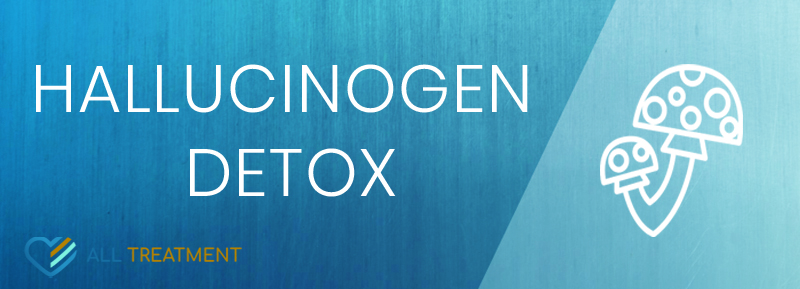 As a class of drugs, hallucinogens cover a broad range of substances, including LSD (acid), psilocybin (magic mushrooms), DMT, marijuana, and PCP. While there is limited research-driven data on the addictive nature of most of these drugs, they are all known to be dangerous, as they are powerful psychedelic substances, many of which can induce intense, otherworldly, and out-of-body hallucinogenic experiences.
As a class of drugs, hallucinogens cover a broad range of substances, including LSD (acid), psilocybin (magic mushrooms), DMT, marijuana, and PCP. While there is limited research-driven data on the addictive nature of most of these drugs, they are all known to be dangerous, as they are powerful psychedelic substances, many of which can induce intense, otherworldly, and out-of-body hallucinogenic experiences.
One drug within this class that has been identified as addictive and extremely dangerous is PCP (phencyclidine), also known as “angel dust.” PCP is known for its dissociative effects, inducing feelings of invincibility, delusions, and intense hallucinations. When abused regularly, PCP has been shown to result in addictive behaviors such as drug-seeking behavior prompted by intense cravings.
Some of the most common effects of PCP withdrawal include the following:
- Memory loss
- Speech difficulties, such as stuttering, slurring, or complete inability to speak
- Damage to the central nervous system
- Extreme confusion
- Increased anxiety
- Agitation
- Depression
- Loss of impulse control
- Weight loss
- Muscle deterioration
- Increased heart rate
- Hyperthermia (elevated body temperature)
- Impaired cognitive function
As with any drug detox, personal health, pre-existing medical conditions, and the severity and length of PCP abuse can be factors in the effects of these withdrawal symptoms, which can linger for several months to a year after detox has been completed. Mental health issues, such as anxiety, depression, or schizophrenia can significantly complicate PCP withdrawal and detox.
During the course of PCP detox, doses of benzodiazepines may be used to ease severe symptoms, such as agitation, psychosis, aggression, and anxiety. In some cases, antidepressants are used during detox due to the potential for continued symptoms of psychosis.
Currently, there are no medications, detox, or treatment protocols specific to PCP or any other hallucinogen. However, the main course of medication for individuals who are going through detox from PCP is a benzodiazepine. Sedation and antidepressant therapies have proven to be the most effective treatment for acute PCP withdrawal.
For individuals engaging in chronic use of any hallucinogen, a medical setting is recommended for detox, in the event of a serious psychological complication.
Alcohol Detox
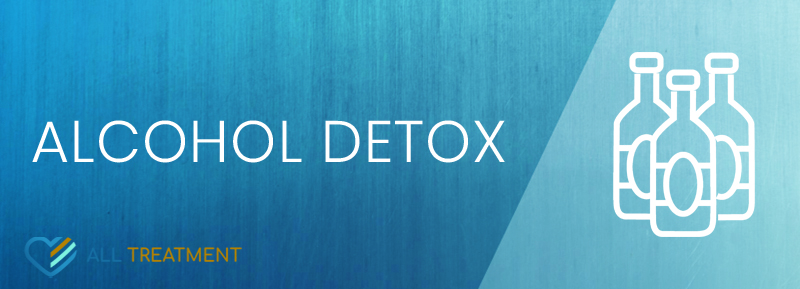 Alcohol detox carries one of the most potentially dangerous sets of withdrawal symptoms, which can be fatal without medical attention. Alcohol addiction manifests itself both physically and psychologically, and the withdrawal symptoms from alcoholism can be moderate to severe. It should be noted that one need not be an alcoholic to experience alcohol withdrawal symptoms, and could also be in need of medical detox.
Alcohol detox carries one of the most potentially dangerous sets of withdrawal symptoms, which can be fatal without medical attention. Alcohol addiction manifests itself both physically and psychologically, and the withdrawal symptoms from alcoholism can be moderate to severe. It should be noted that one need not be an alcoholic to experience alcohol withdrawal symptoms, and could also be in need of medical detox.
Referred to as alcohol withdrawal syndrome in medical circles, alcohol withdrawal can begin within six hours after the last alcoholic drink is consumed and can present the following symptoms:
- Anxiety
- Nausea
- Headache
- Elevated blood pressure
- High heart rate
- Sweating
- Tremors
- Agitation
- Visual, auditory, and tactile hallucinations
- Seizure
- Delirium tremens (also known as DTs)
Since long-term alcohol abuse can cause several serious medical conditions, including cirrhosis, hypertension, and pancreatitis to name a few, thorough medical consultation and assessment are likely necessary before beginning a detox procedure. Alcohol abuse is pervasive throughout the United States, and the risks of detox are directly related to the severity and length of alcohol abuse.
As stated previously, most symptoms of alcohol withdrawal begin within six hours of the last drink, but the onset of severe symptoms peak between twenty-four to forty-eight hours after the last drink. The standard medication for alcohol detox is a long-acting benzodiazepine, such as diazepam (brand name Valium®), to control the risk of seizures and modulate agitation, tremors, and anxiety.
Since the effects and risks of alcohol withdrawal can be extremely severe, with peaks two to three days into the process, alcohol detox should always be performed in a medical setting with adequate supervision and assistance. The time period for alcohol detox to be completed varies based on individual health and the severity of alcohol abuse, but the process typically lasts between three and ten days. After detox, some symptoms of alcohol withdrawal may continue to linger in varying degrees of intensity.
There are three medications which may be prescribed for the treatment of alcohol abuse and cravings after the detox process has been completed:
- Naltrexone (brand name ReVia® or Depade®)
Naltrexone works by blocking the chemicals in the brain, which are related to the rewarding and euphoric effects of alcohol consumption. By doing this, naloxone is effective in reducing or completely eliminating alcohol cravings. - Acamprosate (brand name Campral®)
Acamprosate specifically works to reduce symptoms of alcohol abstinence, which may linger after detox. These symptoms include insomnia, anxiety, restlessness, and dysphoria. - Disulfiram (brand name Antabuse®)
Disulfiram curbs further alcohol abuse, by precipitating a set of immediate and unpleasant effects, upon the consumption of any alcohol. These effects include nausea, flushing, and palpitations.
All three medications are FDA approved for the treatment of alcohol abuse after detox. Alcohol is one of the few substances for which so many medications are available in support of continued abstinence or reduction of alcohol abuse.
Benzodiazepine Detox
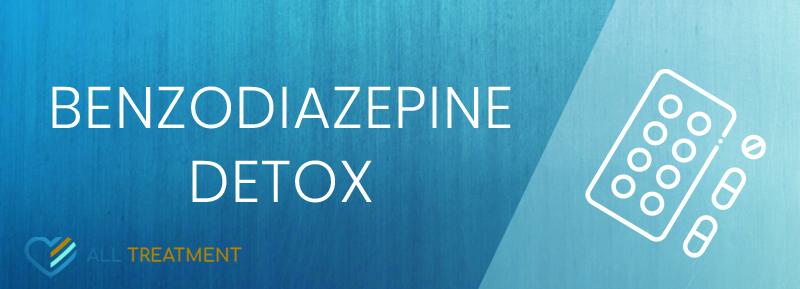 Similar to alcohol, benzodiazepine detox can also lead to a series of moderate to severe medical complications. Benzodiazepine abuse is very common when mixed with another depressant substance, such as alcohol or opioids. With all three drugs being central nervous system (CNS) depressants, the combination of any with a benzodiazepine is extremely dangerous and further complicates the task of benzodiazepine detox.
Similar to alcohol, benzodiazepine detox can also lead to a series of moderate to severe medical complications. Benzodiazepine abuse is very common when mixed with another depressant substance, such as alcohol or opioids. With all three drugs being central nervous system (CNS) depressants, the combination of any with a benzodiazepine is extremely dangerous and further complicates the task of benzodiazepine detox.
Some of the most common symptoms of withdrawal, which need to be addressed in detox, include:
- increased anxiety
- sleep disturbances
- hand tremors
- sweating
- nausea
- dry heaving
- palpitations
- headache
- muscle aches
- perceptual distortions
- panic attacks
- concentration difficulty
- seizure
Benzodiazepine detox typically occurs over a period of five to fourteen days and can often occur in stages. The first one-to-four day stage usually includes what is referred to as “rebound anxiety” and insomnia. The second stage includes a peak of withdrawal symptoms, which can last between ten and fourteen days. The third stage is generalized by a return of anxiety symptoms until such time that some form of therapy is instituted.
The standard protocol for benzodiazepine detox is either phenobarbital or the transfer to a longer-acting benzodiazepine such as diazepam. The most effective manner of safely detoxing a benzodiazepine-addicted individual is to taper down the benzodiazepines in the system. Sudden cessation of these drugs can result in the immediate onset of the aforementioned symptoms, which can lead to serious medical conditions or death without proper medical attention and monitoring. Therefore, t is strongly recommended to seek medical assistance for any attempt to stop taking benzodiazepines, whether alone, or in combination with other substances.
There is currently no medication available to discourage further benzodiazepine abuse, and the most effective option is to seek drug treatment for either abstinence or learning to properly and responsibly use prescribed medication.
Club Drug Detox
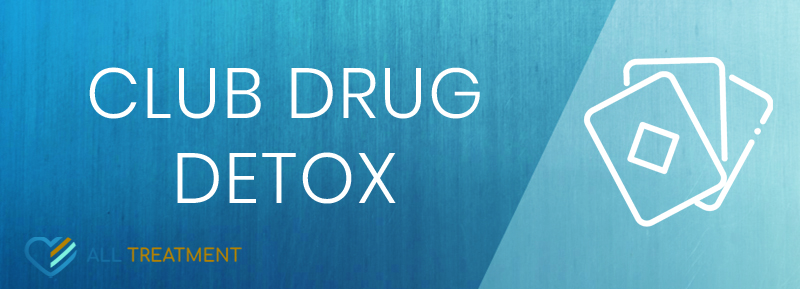 The most popular club drugs—ketamine, MDMA (ecstasy or molly), and GHB—are all addictive, and all can be very dangerous when abused chronically. These drugs have different chemical makeups, but the most direct danger is that they are all engineered in clandestine labs, so it is virtually impossible to know exactly what is in a dose purchased on the street or in any black-market environment.
The most popular club drugs—ketamine, MDMA (ecstasy or molly), and GHB—are all addictive, and all can be very dangerous when abused chronically. These drugs have different chemical makeups, but the most direct danger is that they are all engineered in clandestine labs, so it is virtually impossible to know exactly what is in a dose purchased on the street or in any black-market environment.
Typically, withdrawal from all three of these drugs is more psychological than it is physical and tends not to be medically life-threatening. However, the psychological symptoms and effects can range in severity, and all include intense cravings for more of the drug.
Some of the most severe effects of withdrawal and detox from MDMA can include the following:
- depression
- anxiety
- delusions
- fatigue
- hallucinations
- confusion
- insomnia
- loss of appetite
- irritability
- concentration trouble
- paranoia
- panic attacks
- mood swings
- intense cravings
- psychosis
The symptoms experienced during detox from chronic and heavy GHB use do not tend to be as extensive as MDMA, but can include:
- anxiety
- tremors
- confusion
- delirium
- auditory, visual, and tactile hallucinations
- irregular heart rate
- hypertension
- cravings
Ketamine detox is generally even less intense but can have serious consequences on mental health and cognition.
Detox from chronic ketamine use can result in the following symptoms:
- depression
- irregular heart rate
- cognitive dysfunction
- psychosis
- suicidal thoughts
- cravings
Detox from any club drug, especially after sustained chronic abuse, and/or with pre-existing medical conditions, can result in consequences which range from mild to severe. Detox can also last anywhere from four to fourteen days, with some symptoms lingering for several weeks or months. Due to the intense psychological effects that these drugs have on users, and the intense cravings possibly caused after cessation of use, detox should be immediately followed with a drug treatment program.
For some users, an outpatient program coupled with strong support will be sufficient for recovery. Others may require inpatient or long-term drug rehab. This is recommended for those who have abused one or more of these drugs for an extended period of time, or for whom detox was especially difficult and/or took a long time to complete.
Currently, there are no medications which are approved abuse deterrents for these drugs; therefore the most effective course of action is to seek professional treatment and support groups to maintain abstinence.
ADHD Medication Detox
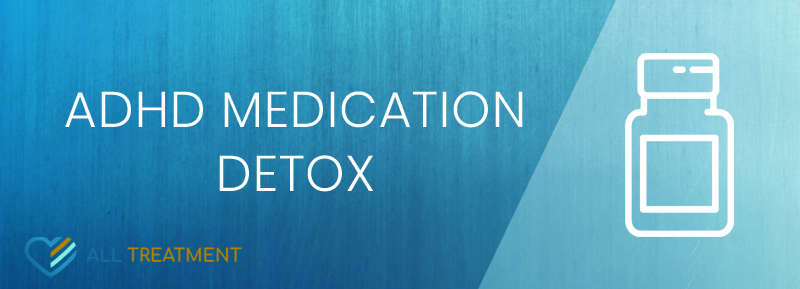 ADHD medications are all stimulant drugs, specifically amphetamines, and have similar actions on the brains of users. In individuals who have legitimately prescribed these medications for ADHD, occurrences of abuse and addiction are very rare. However, when ADHD medications are abused by those who do not have a prescription based on a legitimate medical need, ADHD medications can become extremely addictive, dangerous, and lead to an uncomfortable and complicated detox process.
ADHD medications are all stimulant drugs, specifically amphetamines, and have similar actions on the brains of users. In individuals who have legitimately prescribed these medications for ADHD, occurrences of abuse and addiction are very rare. However, when ADHD medications are abused by those who do not have a prescription based on a legitimate medical need, ADHD medications can become extremely addictive, dangerous, and lead to an uncomfortable and complicated detox process.
Some of the most common symptoms of withdrawal, which extend through and sometimes after detox, include:
- Anxiety
- Paranoia
- Psychosis
- Restlessness
- Fatigue
- Concentration problems
- Depression
- Sleeping Pills Detox increased appetite
- Intense cravings
Often, the symptoms of ADHD medication detox are not severe, but in efforts to reduce effects like anxiety, restlessness, and paranoia, benzodiazepines are commonly used by medical staff. Also, cravings often continue after detox and can be accompanied by anhedonia, an inability to feel pleasure. These symptoms may linger for several weeks or months after detox. In some cases, an antidepressant may be prescribed to treat anhedonia, but in milder to moderate cases, an effective behavioral health therapy combined with support can produce positive results over a six-to-twelve-month period of time.
Detox from ADHD medications may take place in a medical setting, or in an outpatient setting with strong support systems in place. In cases of severe or long-term abuse, it may be necessary to seek inpatient detox for ADHD medications and follow with an intensive drug treatment program.
Sleeping Pills Detox
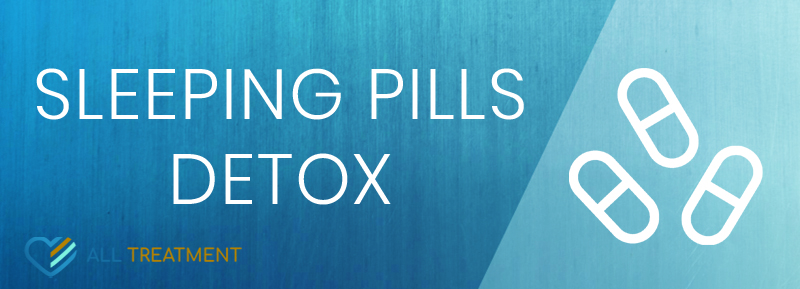 Sleeping pills are hypnotic sedative drugs, and the long-term use or abuse of these prescriptions often leads to dependence. Manifesting both physically and psychologically, dependence on sleeping pills is a common occurrence, and the process of detox from them can be dangerous, similar to benzodiazepine detox, as many of these medications are benzodiazepines.
Sleeping pills are hypnotic sedative drugs, and the long-term use or abuse of these prescriptions often leads to dependence. Manifesting both physically and psychologically, dependence on sleeping pills is a common occurrence, and the process of detox from them can be dangerous, similar to benzodiazepine detox, as many of these medications are benzodiazepines.
The only recommended safe way to stop the use of sleeping pills is to slowly taper down the dosage with the assistance of a physician. Most sleeping pills are not intended for regular or long-term use, and illicit abuse of these medications, especially when combined with other depressant drugs like alcohol and opioids, can be deadly.
Trying to cease use of high dosages, or after long-term use of sleeping pills, can result in the following symptoms and complications:
- Insomnia
- Agitation
- Nausea
- Body spasms
- Anxiety
- Depression
- Fatigue and lethargy
- Hallucinations
- Delirium
- Confusion
- Seizures
- Increased heart rate
- Hand tremors
Since many sleeping pills are benzodiazepines, the withdrawal and detox symptoms are aligned with those of benzodiazepines and can be very risky with sudden cessation of the medication.
Therefore, it is imperative to seek medical consultation and assistance in gradually and carefully tapering down amounts of sleeping pills. A physician can guide this process without the need for medical intake in most cases. However, situations which involve serious abuse of these drugs and/or combinations with other drugs may require more intense medical attention and possible inpatient care.
If an inpatient medical detox of sleeping pills is required, the process will be just as it would with the assistance of a physician: a transition to a long-acting benzodiazepine with a slow tapering down of the dosage. This process may take between five and fourteen days to complete, depending on the severity of abuse and any existing health conditions. It is also important to seek addiction treatment immediately the following detox for any individual who has engaged in abuse of these drugs over a sustained period of time.
Crystal Meth Detox
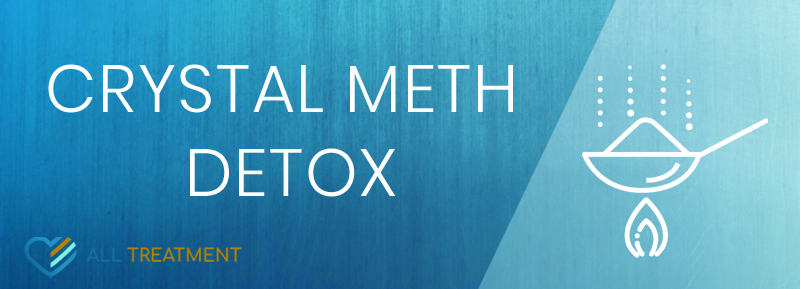 Crystal meth detox has been described as grueling and extremely uncomfortable by many who have experienced it. Although crystal meth is a stimulant like cocaine and ADHD medication, it is made in clandestine labs, with varying ingredients, almost all of which are extremely toxic to the body and brain. Additionally, crystal meth is a stronger and longer-acting drug than its stimulant cousins.
Crystal meth detox has been described as grueling and extremely uncomfortable by many who have experienced it. Although crystal meth is a stimulant like cocaine and ADHD medication, it is made in clandestine labs, with varying ingredients, almost all of which are extremely toxic to the body and brain. Additionally, crystal meth is a stronger and longer-acting drug than its stimulant cousins.
Crystal meth is most often abused in binges, causing people to stay awake for days at a time and sleep for full twenty-four-hour periods when the inevitable crash occurs. Detoxing from crystal meth is more psychological than physical but can have a wide range of effects on users.
Depending on the individual, the severity of addiction, and potential health complications, symptoms of crystal meth withdrawal may include:
- Intense cravings
- Extreme fatigue and lethargy
- Increased appetite
- Severe agitation
- Anxiety
- Insomnia
- Depression
- Anhedonia (inability to feel pleasure)
- Delusions
- Visual, tactile, and auditory hallucinations
- Psychosis
Since crystal meth significantly increases dopamine in the brain, withdrawal from it can lead to severe depression—even suicidal thoughts and ideations. And although crystal meth detox is not generally life-threatening, the mental state of someone going through the process can be life-threatening, without the support and medical assistance. Medications like benzodiazepines may be used to decrease many of the symptoms such as agitation, anxiety, and insomnia. The overall goal of crystal meth detox is for the individual to sleep through it. Many of the psychological symptoms of detox are likely to linger for weeks or months after the process is complete, including intense cravings.
Additionally, crystal meth can do tremendous damage to the brain and its functions, some of which may be irreversible. Learning new skills to cope with these issues and undergoing therapy to live free of further crystal meth abuse are both available in drug treatment programs, which should be entered into immediately following crystal meth detox.
Bath Salt Detox
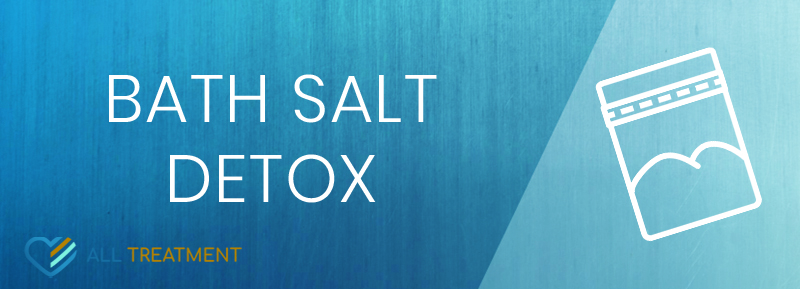 Bath salts are synthetic cathinones, which have a stimulants effect on humans, although all packaging including this substance is labeled as not safe for human consumption. As the name implies, these are bath salts intended to soften and perfume bathwater, but when ingested by humans, they can have devastating effects. Bath salts have been classified by public health officials as new psychoactive substances (NPS) with no safe or approved medical use.
Bath salts are synthetic cathinones, which have a stimulants effect on humans, although all packaging including this substance is labeled as not safe for human consumption. As the name implies, these are bath salts intended to soften and perfume bathwater, but when ingested by humans, they can have devastating effects. Bath salts have been classified by public health officials as new psychoactive substances (NPS) with no safe or approved medical use.
Like many stimulants of abuse, the detox and withdrawal symptoms resulting from bath salt abuse include:
- Depression
- Anxiety
- Tremors
- Insomnia
- Paranoia
- Hallucinations
- agitation
Although there have been numerous reports of addiction to and even death from bath salt abuse, little research has been done on the exact ways in which these drugs affect the human brain.There is also no set medical protocol for detox from these drugs, but with effects similar to other stimulant drugs like cocaine and crystal meth, benzodiazepines would be an appropriate course of medication to ease the symptoms of anxiety, insomnia, and agitation. Currently, there is no specific medication to treat bath salt abuse and addiction, but the National Institute on Drug Abuse (NIDA) confirms that the only way to treat bath salt abuse and addiction is with behavioral therapy offered by a drug treatment program.
Kratom Detoxification
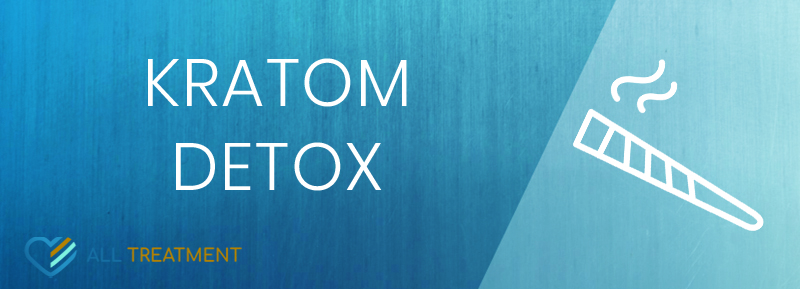 Relatively new on the drug scene, kratom has opioid-like effects on users, and in smaller doses, stimulant effects. Highly scrutinized by the FDA, kratom has been labeled as an opioid with no medical use, and the FDA has cited serious concerns over health risks, with more than forty deaths in the United States having been associated with the drug.6 Kratom is addictive and has limited dosing information due to its lack of approved medical uses and adverse effects with its use.
Relatively new on the drug scene, kratom has opioid-like effects on users, and in smaller doses, stimulant effects. Highly scrutinized by the FDA, kratom has been labeled as an opioid with no medical use, and the FDA has cited serious concerns over health risks, with more than forty deaths in the United States having been associated with the drug.6 Kratom is addictive and has limited dosing information due to its lack of approved medical uses and adverse effects with its use.
Much research remains to be done regarding the safety and efficacy of kratom, but many people addicted to opioid and heroin use the drug for ease of withdrawal symptoms, and some continue to use it as a maintenance drug, much like methadone and buprenorphine. However, there is no current FDA approval for any medical use of kratom.
For individuals who have become dependent on kratom, withdrawal symptoms can mimic those of opioid withdrawals, as well as some dangerous psychological symptoms, which can include:
- Nausea
- Diarrhea
- Fever
- Joint and muscle pain
- Irritability
- Hostility
- Depression
- Insomnia
- Cravings
- Runny nose
- Mood swings
- Kicking and twitching of limbs
- Hot flashes
Since kratom is classified as more of an opioid than a stimulant, medical treatment is recommended for detox from this substance. There is no standard medical protocol due to a lack of research-based information on all possible effects. However, anyone undergoing a kratom detox in a medical setting is likely to receive benzodiazepines or similar medications to reduce some of the symptoms, and in efforts to induce sleep. Typical detox from kratom may last between five and ten days, with peaks in acute symptoms presenting between days one and three.
With limited knowledge of the long-term effects of kratom after detox, it is best to seek immediate medical attention before attempting to stop chronic or long-term use of the drug. Further, it is highly recommended to follow detox with an inpatient or residential drug treatment program. Unknown long-term effects preclude the medical community from establishing a treatment protocol for kratom addiction, other than drug treatment and behavioral therapies to prevent further abuse of the drug.
Polysubstance Detox
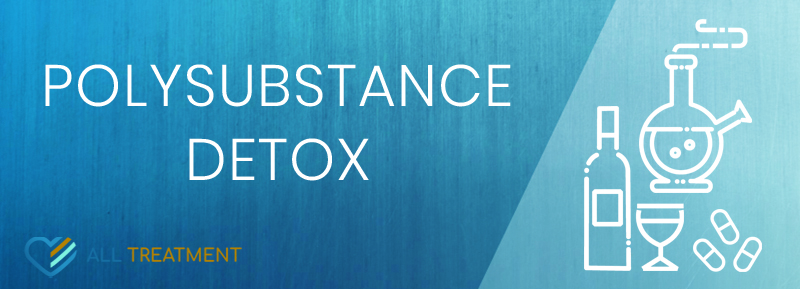 Polysubstance abuse is the abuse of three or more drugs simultaneously. This can be any combination of stimulant, depressant, sedative-hypnotic, or hallucinogenic. The majority of individuals who are addicted to one drug also engage in some form of polysubstance abuse, but the use of more than two drugs does not necessarily constitute an addiction to all. In the cases where an individual is actually addicted to more than two substances, a medical detox is necessary to address the multiple complications, which may occur during the detox process.
Polysubstance abuse is the abuse of three or more drugs simultaneously. This can be any combination of stimulant, depressant, sedative-hypnotic, or hallucinogenic. The majority of individuals who are addicted to one drug also engage in some form of polysubstance abuse, but the use of more than two drugs does not necessarily constitute an addiction to all. In the cases where an individual is actually addicted to more than two substances, a medical detox is necessary to address the multiple complications, which may occur during the detox process.
For example, withdrawal symptoms associated with depressants and those associated with hallucinogens may present complications, which would need to be assessed by medical professionals with knowledge of drug interactions and potential side effects. An individual attempting to self-medicate would not be able to properly identify the acute causes of one symptom and to accurately counter it without risks of serious medical complications.
In the case of polysubstance abuse and addiction, it is imperative to seek medical consultation first, followed by immediate admission to an inpatient treatment facility where detox can be professionally completed. Depending on individual circumstances, polysubstance detox may take anywhere from five to fourteen days to complete, perhaps longer if medical conditions exist, which may prolong or complicate the process. Regardless of the time it takes, it is recommended that any individual who is abusing or addicted to multiple drugs seek immediate drug treatment upon the completion of detox.
Detox is Not Drug Treatment
It cannot be stressed enough that entering into and completing detox is not the same as drug treatment. In any case of addiction to one or more drugs—the result of abuse or misuse—drug treatment is critical. The circumstances of the addiction, which include length and severity of the addiction, tolerance to the drug, and co-occurring mental health issues, are important factors to consider when deciding on the best treatment plan for recovery. In any event of drug addiction, an effective drug treatment program is the best way to get life back on track and be able to engage in a healthy and productive lifestyle.
- Detox is a necessary first step to recovering from drug addiction, but it does no more than removing the drugs from one’s system and does not begin to address the addiction itself.
- Considering the pain, discomfort, and potential complications of drug detox, it is highly ill-advised to put one’s body through the process without a drug treatment program and recovery plan to follow, significantly decreasing the chances of relapse and the need to start over again.
- Drug detox is available throughout the United States, and most drug rehabilitation facilities offer detox as a part of their treatment, for a seamless transition from detox directly into a critically important treatment program.
There is never a need to attempt drug detox alone, as what may seem like it’s possible as a do-it-yourself process can quickly lead to complications, and potentially deadly consequences.
Resources:

